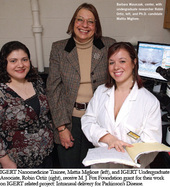Highlight
IGERT Trainee Research Highlights
Achievement/Results
IGERT trainees carry out cutting-edge research in the burgeoning field of nanomedicine. The research is interdisciplinary in nature and tries to address major medical challenges through the use of nanotechnology. Findings from these research projects have been presented at several national conferences and resulted in numerous publications in peer-reviewed journals.
Address Goals
IGERT Trainee: Mattia Migliore Advisor: Dr. Barbara Waszczak Project Title: Intranasal Delivery of GDNF Using Cationic Liposomes
Parkinson’s disease is associated with degeneration of dopamine neurons in the brain and glial cell line-derived neurotrophic factor (GDNF) is known to facilitate damaged dopamine neurons. However, delivery of these GDNF in the brain has been a challenge. IGERT fellow Mattia Migliore is using cationic liposomes, to administer the drugs to the brain through the intranasal passage. This intranasal drug delivery method will be used to deliver GDNF in the treatment of Parkinson’s disease. Results from this initial work has been recognized by the Michael J. Fox Foundation for Parkinson’s Research and has awarded a $75,000 Rapid Response Innovation Award for this research work.
Additionally, this work was presented at the Society for Neuroscience Convention at San Diego, CA, 11/05/2007
IGERT Trainee: Tatyana Chernenko Advisor: Dr. Max Diem Project Title: Novel Approach to Imaging of Nano-Drug-Delivery Carriers Based on Raman Microscopy
Cell targeting has been the growing field of interest in gene therapy and anticancer treatments. Of particular interest are pharmaceutical drug delivery systems, such as micelles and liposomes. In this project, Raman micro-spectroscopic techniques are being explored which are based on vibrational spectroscopy coupled with optical microscopy to provide a non-invasive and non-destructive method for cellular imaging. This technique provides a novel method to spectroscopically map the biochemical components of an individual cell. The objective of this work is to identify the presence of liposomes within a cell and map their concentration and distribution therein.
Publications and presentations: Matthäus, C., Chernenko, T., Newmark, J. A., Warner, C. M., & Diem, M. (2007). Label-free detection of mitochondrial distribution in cells by nonresonant raman micro-spectroscopy. Biophysical Journal: 93, 668. Matthäus, C., Kale, A., Chernenko, T., Torchilin, V., & Diem, M. (2008). New ways of imaging uptake and intracellular fate of liposomal drug carrier systems inside individual cells based on raman microscopy. Molecular Pharmaceutics: 5, 287. Romeo, M. J., Boydston-White, S., Matthaeus, C., Miljkovic, M., Bird, B., *Chernenko, T., Lasch, P., & Diem, M. (2008). Infrared and raman microspectroscopic studies of individual human cells. In M. Diem, P. R. Griffiths, & J.M. Chalmers (Eds.) , Vibrational Spectroscopy for Medical Diagnosis (pp. 27-76). Indianapolis, IN: Wiley.
IGERT Trainee: Luis Brito Advisor: Mansoor Amiji Project Title: Targeted eNOS Gene Delivery with Lipopolyplexes for the Treatment of Coronary Restenosis
Non-viral gene delivery and transfection in primary human vascular endothelial cells (EC) and smooth muscle cells (SMC) has tremendous potential for cardiovascular diseases, such as in the treatment of restenosis. In this study, lipopolyplexes were made by pre-condensing plasmid DNA, expressing enhanced green fluorescent protein (EGFPN1), with poly(beta-amino ester) (PBAE) and then encapsulating in DOTAP liposomes. The positively-charged lipopolyplexes were found to efficiently transfect EC and SMC as determined by qualitative and quantitative analysis. The results of this study show that PBAE-DOTAP-plasmid DNA lipopolyplexes embedded in gelatin is a promising non-viral vector system for gene delivery and transfection in EC and SMC.
Presentations and Publications: Targeted Gene Delivery with Lipopolyplexes for the Treatment of Coronary Restenosis, Luis Brito, American Chemical Society, New Orleans, 04/05/2008 Gene Delivery and Transfection Studies with Lipopolyplexes in Human Endothelial and Smooth Muscle Cells. Luis Brito, Nano DDS Conference, 11/02/2007 Poly(beta-amino ester) and Cationic Phospholipid-Based Lipopolyplexes for Gene Delivery and Transfection in Human Aortic Endothelial and Smooth Muscle Cells, Brito L, Little S, Langer R, Amiji M., Biomacromolecules, V.Online pre-release, P.0 (2008) Nanoparticulate carriers for the treatment of coronary restenosis, Brito L, Amiji M., Int J Nanomedicine., V.2, P.143 (2007)
IGERT Trainee: Padmaja Magadala Advisor: Mansoor Amiji Project Title: HER2/neu Receptor-Targeted Gelatin-Based Nanovectors for Pancreatic Cancer Gene Therapy
In Pancreatic cancer, over 80% of the human pancreatic cancer expresses epidermal growth factor family of receptors on the cell surface. In this research project, potential of epidermal growth factor receptor (EGFR)-targeted gelatin-based engineered nanovectors (GENS) for plasmid DNA delivery and transfection in pancreatic cancer cells is being examined. EGFP-N1 plasmid coding for green fluorescent protein (GFP), was encapsulated in gelatin nanoparticles with a PEG chain and a 15-mer EGFR binding peptide. Results of this study showed that EGFR-targeted gelatin-based nanovectors can serve as a safe and efficiency carrier for potential in vivo gene therapy.
IGERT trainee, Padmaja Magadala, won the International Society of Pharmaceutical Engineer’s (ISPE) Boston area poster competition for this work.
Magadala, P., van Vlerken, L.E., Shahiwala, A., & Amiji, M.M. (2008). Mutifunctional polymeric nanosystems for tumor-targeted delivery. In V. Torchilin (Ed), Multifunctional Pharmaceutical Nanocarriers: Development of the Concept (pp. 33-66). New York, NY: Springer Publishing. HER2/neu – Targeted Gelatin-based nanoparticles for gene delivery and transfection in pancreatic cacer cells. Magadala, P. American Association of Pharmaceutical Scientists Annual Meeting and Expo, San Diego, CA. November 2007. HER2/neu – targeted gelatin-based nanoparticles for gene delivery and transfection in pancreatic cancer cells. Magadala, P. and Amiji, M.M., Nano DDS Conference, Boston, MA, November, 2007.






